Top News
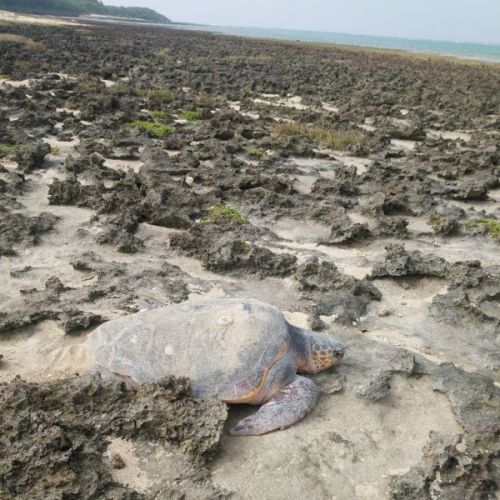
May 6, 2021 Ryukyu Shimpo
On May 5, a loggerhead sea turtle was discovered on the shore in Kyan in Itoman. The turtle was found stuck on the rocks after laying her eggs. Approximately 20 people, including locals, the Turtle Hermit, who loves turtles, police, and aquarium employees, rushed to the spot and began efforts to rescue the turtle.
“A sea turtle laid her eggs, but hasn’t returned to the sea.” Koki Tokumura (Kyan, Itoman) received word from an acquaintance who came to his home at around 9 a.m. Tokumura is known as a turtle-lover, and does a radio show in Okinawa under the radio name Turtle Hermit (Kame Sennin). For the past 9 years, he has conducted independent patrols while out walking, in order to protect sea turtles laying their eggs on the beach near Kyan Fishing Port.
After his acquaintance told him the news, Tokumura went directly to the spot: a beach approximately 500 meters south of Kyan Fishing Port. The turtle had finished laying her eggs and was on her way back to the sea when the tide had gone out, leaving the lone turtle stuck on the rocks, about 15 meters from the water.
Seeing the turtle, Tokumura decided that he needed help and called 110. Two officers rushed to the spot from the Kohagura and the Komesu Substations of the Itoman Police Department. Locals who had heard about the turtle also turned up. The locals covered the turtle with a vinyl sheet to keep her warm, and expressed hopes for her safety. In the afternoon, two employees who care for sea turtles at the Okinawa Churaumi Aquarium, including Ken Maeda, arrived. They had received a call from the police. The aquarium employees skillfully wrapped the turtle in a net and placed her in a plastic basket. Then, with help from Tokumura, the police, and around 8 local adults, they carried the turtle to their truck, rescuing her.
Movie and Photos = http://ryukyushimpo.jp/photo/entry-1316664.html
According to Maeda, the sea turtle is somewhere between 20 and 30 years old, about 1 meter long, and weighs around 100 kilograms. “Her injuries were very minor, and she is healthy.” Sea turtles lay their eggs between May and September. Maeda offered a possible explanation for why the turtle was unable to return to sea: “I’d guess that there were people having beach parties during Golden Week. Sea turtles hate artificial light and signs of people, so it is possible that she laid her eggs in a different spot than usual, or tried to return to sea along a different route.” The rescued turtle will be cared for at Churaumi Aquarium as they keep an eye on her injuries, and then she will be returned to sea.
Tokumura, the Turtle Hermit, lifts his signature glasses, narrows his eyes, and says “I’m glad her injuries were minor. I’m going to continue the patrols until I die.”
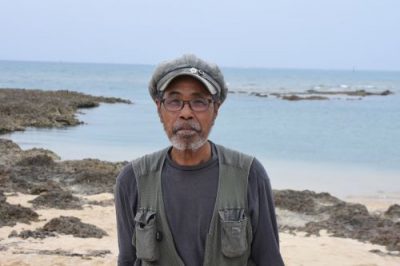
“I’m glad her injuries were minor.” Koki Tokumura, the Turtle Hermit, celebrates the turtle’s rescue. (May 5, the shore in Kyan, Itoman)
(English translation by T&CT and Ellen Huntley)
Go to Japanese
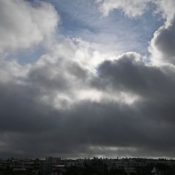
May 5, 2021 Ryukyu Shimpo
The Okinawa Meteorological Observatory (OMO) announced the morning of May 5 that it appears the Okinawa region has begun their rainy season. A similar announcement was made in Amami the same day, making both regions the first in Japan to enter the rainy period. This year’s start is five days earlier than average years, and eleven days earlier than the previous year.
With a coming storm front and humid atmosphere, the weather outlook calls for rain this evening through the following morning.
According to the OMO’s monthly weather forecast released on April 29, the number of cloudy and rainy days through May 31 will be less than average years, and rainfall will be average or slightly below average.
The rainy season in Okinawa usually runs through around June 21.
(English translation by T&CT and Sam Grieb)
Go to Japanese
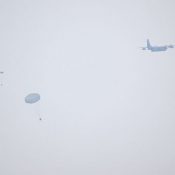
May 5, 2021 Ryukyu Shimpo
On May 4, the US miltary conducted parachute drop training over the water in Tsuken Jima Training Area in Uruma City, Okinawa. This is the sixth time this year that training was conducted in this water training area. Starting at just past 10:10 a.m., soldiers parachuted from an MC-130J special operations aircraft that is stationed at Kadena Air Base. It appears supplies were also dropped. After the drop, soldiers rode in boats on standby on the water and then landed at the U.S. military’s White Beach.
After the soldiers performed drop training, the MC-130J aircraft was observed flying at a low altitude in the air over Tsuken Jima. It is possible that the aircraft flew at as low an altitude as 500 feet (approximately 150 meters). According to eyewitness testimony, after that, it seems that the aircraft flew at a low altitude in the skies over the Kerama Islands and Amami Oshima. Parachute drop training has been being conducted at the Tsuken Jima Training Area since March 12. As it stands, in terms of how often parachute drop training is conducted, there is a risk that this year will surpass the annual maximum (11 times). The Federal Aviation Administration (FAA) issued aviation information (a notice to airmen) prior to the training. The Okinawa prefectural government asked the Okinawa Defense Bureau (ODB) to work to suspend this training. The Uruma City Council made a visit to the ODB in February to submit a written opinion asking for the ODB to act to have drop training no longer take place.
(English translation by T&CT and Erin Jones)
Go to Japanese
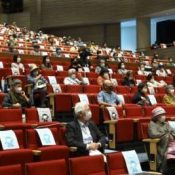
May 4, 2021 Ryukyu Shimpo
On May 3, Constitution Day, the 2021 Constitution Symposium (Okinawa Constitution Dissemination Association, Okinawa Human Rights Association, Japan Scientists’ Association Okinawa Branch) was held at the Ryukyu Shimpo Hall in Izumizaki, Naha. Physician Yasuharu Tokuda, age 57, from Nanjo, who is the director of the Muribushi Okinawa Clinical Research Center, spoke about the significance of habitually engaging in peace activities, saying, “as a physician, the most important thing is making sure that war is not carried out.”
Dr. Tokuda discussed an exchange he had with former hospital director Shigeaki Hinohara when working at St. Luke’s International Hospital in Tokyo. He told of how he learned from Dr. Hinohara the importance of not letting war occur and that “the important thing is not ‘renunciation of war,’ that is, not fighting, but rather ‘non-war,’ that is, actively preventing war from being carried out.”
He also pointed out, from the perspective of a physician, that “U.S. military bases are not just a human rights problem; they are also a health problem.” He explained that accidents and crimes by people associated with the U.S. military, as well as the noise and environmental pollution caused by the bases, increase the risk of illness, and said, “we are the ones who these sick patients come to; we cannot merely treat them in silence,” revealing a reason for doctors to promote peace. He declared that he will continue engaging in peace activities and called on the audience to participate in peace activities as well.
Tomoko Miyagi of “Team Midorigaoka 1207,” a group formed primarily of parents of children attending the Midorigaoka Nursery in Ginowan after part of a U.S. military aircraft fell on the nursery grounds in December 2017, also reported on the group’s activities. She showed footage of U.S. military aircraft flying over the nursery and emphasized, “our demand is that [the U.S. military] adhere to its flight route and not fly over the nursery.” She also said, “we will not give up in our efforts to achieve an environment where our children can play and learn safely.” Because of Covid-19, the audience was limited to 150 people, and the event was also streamed online.
(English translation by T&CT and Sandi Aritza)
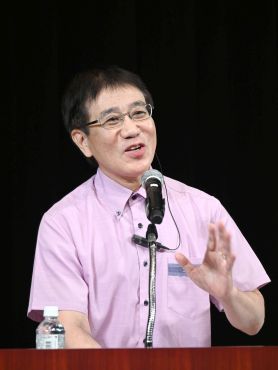
Dr. Yasuharu Tokuda
Go to Japanese
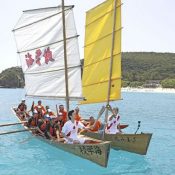
May 3, 2021 Ryukyu Shimpo
Zamami – The flame of peace made its way through the Kerama blue sea under the glittering rays of sunshine. The Olympic torch traveled through Zamami Village aboard traditional sabani sailboats. Many of the village’s residents gathered at Furuzamami Beach where the event took place to witness the historic moment.
Carrying the torch was Okinawan-born actor Shogen, 42, and Yoji Ichimura, 68, who runs a black pearl farm in Zamami. The sabani boats used were two racing boats, the “Zamami-maru” and the “Kai-gakou” (literally sea school), powered by men from the village and third year students from Zamami Junior High. Shogen, who was aboard the Kai-gakou, was passed the Olympic flame on the water in a “torch kiss” by Ichimura, who was aboard the Zamami-maru. There was applause and joyous shouts from the beach, and the boats were cheered on by a local group of hula dancers and the “Aka-Geruma Kujira taiko drummers.” Haruna Kakibana, 36, who come to the beach with her children, said, “Being able to see the Olympic torch relay on the beautiful Zamami ocean was a moment of pride for the people of the village.”
After passing the torch, Shogen commented, “The flame of the torch is now joined in my mind with the shouts the students yelled while rowing the sabani boats. Sukai Nakamura, 14, one of the rowers, said with a sigh, “We were able to pass the torch without any issues.” Konomi Itomine, 14, who steered the boat, said happily, “It will make a great memory.”
(English translation by T&CT and Sam Grieb)
Go to Japanese
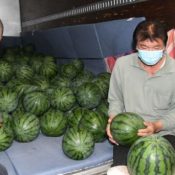
April 30, 2021 Ryukyu Shimpo
Nakijin – Nakijin, known for being home to many of Okinawa’s watermelon producers, is entering their peak harvesting season for watermelon. This year was blessed with excellent weather conditions, and it appears that has resulted in a superior yield of large watermelons with an average sugar content of 11%. Toru Yamashiro, vice president of “Nakijin Watermelon,” located in the Nakaoshi neighborhood of Nakijin, announced happily that, “This is a banner year for watermelons.”
On April 29, many trucks from Nakijin Watermelon could be seen packed with produce boxes filled with freshly picked watermelon. Over 1,000 fruits were harvested on that day alone.
In May of the previous year, COVID-19 cases were quickly on the rise, causing distribution to stagnate and resulting in a large surplus of inventory. This year, with markets back to relatively normal operation, the same surplus issues are not reoccurring.
Nakijin Watermelon president Susumu Yonamine said, “I want people to taste the summer flavor of our watermelon and get through the coronavirus pandemic.”
(English translation T&CT and Sam Grieb)
Go to Japanse
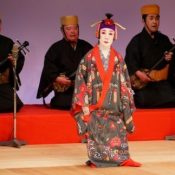
April 26, 2021 Ryukyu Shimpo
On April 25, holders of the Important Intangible Cultural Property certification in Ryukyu buyo (dance) put on a show titled Ichiyo Raifuku: Pre-celebratory Dance–Bonds of Golden Fortune at the Ryukyu Shimpo Hall in Naha City. The concert comprised twelve numbers; living national treasure Noho Miyagi and seven other holders of the first Important Intangible Cultural Property certification (2009) in kumiodori tachikata (dance duet) gave dance performances and two living national treasures gave solo song performances. The masters collaborated hoping for a brighter future in the post-pandemic world. The show was held as part of the Shimpo Art Renaissance Shimpo no Toki program.
The event opened with the singing of classical music by four schools of Ryukyu classical music. Noho charmed the audience with his beautiful and ephemeral depiction of a courtesan who sends off her love and is left dismayed in the piece hanafu. As soloists, Yoshiharu Nishie, the kumiodori-song and sanshin (Okinawan banjo) living national treasure, performed the Niage Nakafubushi and Ichio Nakamura, Ryukyu classical music living national treasure, performed Nakama-bushi. The show closed with a lively dance performance of Kana-yo Amaka by sisters Yoshiko Tanita and Mieko Kinjo, with the audience clapping along.
(English translation by T&CT and Monica Shingaki)
Go to Japanese
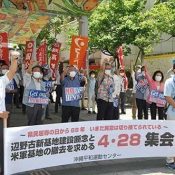
April 29, 2021 Ryukyu Shimpo
April 28 marked 69 years since the Treaty of San Francisco of 1952, which separated Okinawa from Japan, came into effect. On this day, the Okinawa Peace Movement Center held an April 28 Day of Humiliation demonstration at the Kenmin Hiroba Plaza in Naha. Participants criticized the noise, incidents, and accidents caused by the U.S. military, and voiced their hopes for a peaceful Okinawa. They also renewed their resolve to call on the Japanese government to respect the will of the people. The number of attendees was limited due to Covid-19 safety measures. Approximately 50 people participated.
In his comments, Hiroji Yamashiro, chair of the Okinawa Peace Movement Center, touched on the fact that next year marks the 50th anniversary of Okinawa’s reversion to Japan. “With the reversion to Japan, Okinawans hoped to be rescued from the violent administration of the U.S. military. We are still far from achieving the peaceful society that Okinawans want.”
(English translation by T&CT and Ellen Huntley)
Go to Japanese
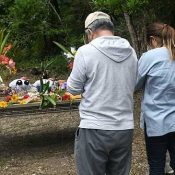
April 29, 2021 Ryukyu Shimpo
April 28 marked five years since the occurrence of an incident in which a man in U.S. military employ sexually assaulted and killed an office worker in the central part of Okinawa Island. People visited the site in Afuso, Onna Village where the woman’s body was abandoned to mourn her. With heavy hearts, they calmly prayed for such an incident to never happen again.
Letters and offerings, such as strings of paper cranes, contributed up the this point with the consent of the bereaved family have been lined up around the flower table, and even warm coffee has been offered so that the victim will not be cold.
Muneko Yabiku, 80, of Kin Town wiped away tears, saying that the victim’s “life moving forward was cut short.” Yabiku also said, “The way in which the government is pushing forward with base construction, despite many people having fallen victim to U.S. military incidents and accidents up to this point, is vexing. Isn’t there something more each of us Okinawan citizens could do?”
The first time Hanako Ueki, 47, of Uruma City visited the site she said that she did not want to let anyone weather such an incident again. She said, “The anger and sadness welled up once more. The same thing must not happen again. I want to share my thoughts with family and friends.”
Former Mayor Katsuhiro Yoshida, 76, of Kin Town, who bore responsibilities such as cleaning up the site after the incident, touched on the current state in which incidents by the U.S. military continue to occur and revision of the Status of Forces Agreement is not moving forward. He said, “[This incident is] unforgettable and must not be repeated. We must continue asking ourselves what we can do to make this happen.”
(English translation by T&CT and Erin Jones)
Go to Japanese
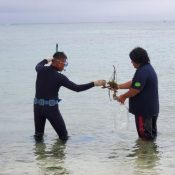
April 24, 2021 Ryukyu Shimpo
By Megumi Kiyomura
On March 29, which is “Hinoene” in February of the lunar calendar, the traditional ceremony “Upuri” was held on the shore in Tarama Village. The “nissaigassa” in charge of ritual ceremonies and local “aza” district officials placed insect pests on an “insect boat” and sank them into the sea while praying for a bountiful harvest.
Upuri is a ceremony for protection against insect pests in which insect pests are captured in the early morning, wrapped in kuwazuimo (giant taro) leaves, and placed on an insect boat made from tree branches. Then, when the tide is low, aza officials carrying the insect boat swim offshore and sink the boat into the sea.
Tsunemi Nakasuji, the nissaigassa of Tomari Utaki, said, “We sent the insect pests offshore with a prayer for a bountiful harvest across the island. We hope that only good will come.”
(English translation by T&CT and Sandi Aritza)
Go to Japanese
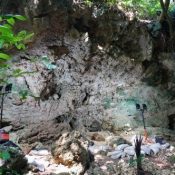
April 24, 2021 Ryukyu Shimpo
By Yukari Miyazawa
Okinoerabujima – The sakumadata tomb cluster’s tomb no. 7 ruins, which was discovered in Otsukan in China, Kagoshima in June last year, was confirmed to be the oldest rock-shelter tomb found in the Amami islands to date.
An archeological dig was conducted on the site by the China Board of Education last November, and fragments of Kamuiyaki pottery (earthenware made in Tokunoshima from the 11th to 14th century) were discovered along with over 30 human bones and teeth. Three of these were tested to have their age determined, and it was confirmed that one of them came from the 11-12th century.
It was hypothesized that the Kamuiyaki pottery, based on its shape, was an 11-12th century burial accessory that had been entombed with the deceased, and the dating of the remains places the bones and the pottery fragments in the same time frame. It provides evidence that the sakumadata tomb cluster’s tomb no. 7 was used as a burial site from the 11th to 12th century.
On March 29, China mayor Rikio Imai spoke with the press at the burial site, commenting, “The ruins are valuable for research on the evolution of burial sites in the Ryukyu Islands. We want to continue with excavation while opening the site for public viewing.”
(English translation by T&CT and Sam Grieb)
Go to Japanese













 Webcam(Kokusai Street)
Webcam(Kokusai Street)


